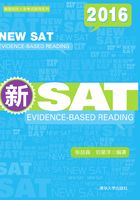
Ⅳ.Key Features
The redesigned SAT reading test emphasizes on four key features:
1.Words in extended context and word choice for rhetorical purposes;
2.Command of evidence in support of conclusions and inferences;
3.Inclusion of graphics for information interpretation;
4.Text complexity range from grades 9 to postsecondary entry.
Words in Context
Different from the current SAT reading test, the word in context questions are not testing vocabulary, but focus on the rhetorical purposes of the words in extended contexts.The following passage excerpt and the two sample questions demonstrate the difference between the word in context questions in the current SAT and in the redesigned SAT.
The coming decades will likely see more intense clustering of jobs, innovation, and productivity in a smaller number of bigger cities and city-regions.Some regions could end up bloated beyond the capacity of their infrastructure, while others struggle, their promise stymied by inadequate human or other resources.
Richard Florida, The Great Reset,2011
1.As used in line 3, “bloated”mostly nearly means:
A.swollen
B.outrageous
C.pampered
D.expanded
E.limited
This is an example of word in context question in the current SAT reading test.The best answer is choice D.To answer this question, students need to know the meaning of the asked word as well as those of the words in the answer choices.The purpose of the question is to test how accurately students can interpret the meaning of a word in context while choosing among words that are given to test students'vocabulary.
2.As used in line 1, “intense”most nearly means:
A.emotional
B.concentrated
C.brilliant
D.determined
This is an example of word in context question in the redesigned SAT reading test. The best answer is B.The word“intense”is neither obscure nor specific to any domain but a high utility word.The purpose of the question is to evaluate students' understanding of the word based on contextual clues.
Command ofEvidence
When doing the SAT reading test, students are not only required to comprehend information and ideas, but also tested for drawing reasonable conclusions and inferences based on supporting evidences in the passage.The following passage excerpt and the sample questions illustrate command of evidence.
Sleep-deprived people are known to have stronger reactions to negative experiences, but some patients with depression seem to perk up with lack of sleep.To resolve this paradox, Matthew Walker at the University of California, Berkeley, and his team used functional magnetic resonance imaging to scan the brains of 14 people who hadn't slept for about 36 hours while presenting them with emotionally neutral and pleasant-looking images.The volunteers rated a greater proportion of the images as“pleasant”than did people who had maintained a normal sleep routine.The sleep-deprived individuals also showed increased activation in brain regions that mediate reward-driven behavior, as well as greater connectivity between certain visual and emotional processing centers.The results suggest that sleep deprivation can enhance reactivity to both positive and negative stimuli.
Neuroscience: No sleep, better mood,2011
Based on Walker's research, what is the most likely explanation for the observation in line 2(“but some...sleep”)?
A.People with depression often have difficulty sleeping.
B.There is a positive relation between sleep deprivation and positive stimuli.
C.There is a negative relation between sleep deprivation and positive stimuli.
D.The emotions of people with depression are easier to manipulate.
To answer the question, students need to identify evidence given in the passage to explain the reason behind the observation.The best answer for Question 1 is B.Line 9—13 provides the evidence from the study: when sleep deprived, human's brain regions that mediate reward-driven behavior become more active and the emotional processing centers are more sensitive to visual stimuli.
Informational Graphics
A new feature in the redesigned SAT Reading is the inclusion of informational graphics.There are two passages which include one or two graphics such as tables, graphs, and charts.Students are asked to interpret and integrate the information in the graphics and in the text.The following passage excerpt and the sample question help illustrate this concept.

Martínez-Botíhave used boron isotopes from planktonic fossils to determine past differences between the partial pressures of CO2in the ocean and the atmosphere(ΔpCO2, measured in microatmospheres)in the eastern equatorial Pacific Ocean(EEP)and the South Atlantic Ocean(SA).They find that ΔpCO2in the EEP was negative, on average, during the latter part of the last ice age(25000 to 19000 years ago), implying that the ocean absorbed CO2from the atmosphere.During the glacial termination, which is about 18000 to 11000 years ago, average ΔpCO2at both sites was positive.This suggests that the ocean released CO2to the atmosphere at both locations at that time, which probably contributed to the overall rise in atmospheric CO2levels between the ice age and the following, milder Holocene epoch.Data for the modern ocean(solid lines)are from ref.3.Squares represent mean values; vertical bars represent the full range of values for each period.
Based on the passage and the graph, which of the following statement is true?
A.As the partial pressures of CO2in the ocean and the atmosphere go higher, the more CO2the ocean absorbs.
B.The South Atlantic Ocean releases more CO2than the eastern equatorial Pacific Ocean since the Ice Age.
C.The eastern equatorial Pacific Ocean releases more CO2than the South Atlantic Ocean since the Ice Age.
D.The lower the latitude, the more CO2the South Atlantic Ocean releases into the atmosphere.
Based on the information given in the graph and the text, the best answer is C. Line 4—6(They find that...atmosphere)sets the foundation of the logic to interpret the relations between the partial pressures of CO2in the ocean and the atmosphere and the amount of CO2release or absorbed by the oceans.
Text complexity
The college board specifies that the SAT reading test includes passages with text complexity levels range from grades 9—10 to postsecondary entry.This change not only reinforces the connection between K-12 education and college entrance test, but also ensures the range of text difficulties on test forms are comparable.